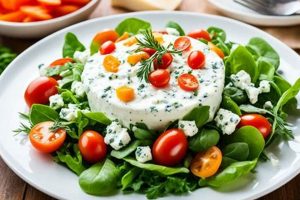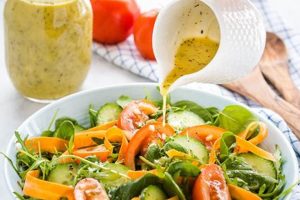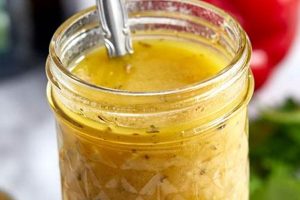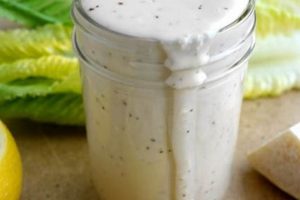A simple yet flavorful vinaigrette featuring two key ingredients extra virgin olive oil, prized for its rich flavor and health benefits, and fresh lemon juice, which provides acidity and brightness forms the base of this classic dressing. Often enhanced with herbs, spices, or other flavoring agents like garlic or Dijon mustard, this versatile emulsion complements a wide array of salads and vegetable dishes.
This blend offers a healthy and refreshing alternative to heavier, cream-based dressings. The monounsaturated fats in olive oil contribute to heart health, while lemon juice offers vitamin C and antioxidants. Its simplicity allows for easy customization, catering to diverse palates and dietary needs. Variations of this dressing have been used for centuries in Mediterranean cuisines, highlighting the enduring appeal of fresh, natural ingredients.
The following sections will explore the core components of this culinary staple, offering detailed guidance on ingredient selection, preparation techniques, and creative variations to elevate your salads from simple to spectacular.
Tips for Crafting the Perfect Olive Oil and Lemon Dressing
Achieving a balanced and flavorful dressing requires attention to detail and an understanding of the interplay between ingredients. These tips offer guidance for creating a superior emulsion.
Tip 1: Use High-Quality Olive Oil: The foundation of a great dressing lies in the quality of its oil. Opt for extra virgin olive oil, preferably cold-pressed, for the best flavor and health benefits.
Tip 2: Freshly Squeezed Lemon Juice is Essential: Bottled lemon juice often contains additives and lacks the vibrant flavor of freshly squeezed lemons. Invest in a good quality citrus juicer for optimal results.
Tip 3: Balance is Key: The ratio of oil to acid is crucial. A general guideline is three parts oil to one part lemon juice, but adjustments can be made to suit individual preferences. Taste and adjust accordingly.
Tip 4: Emulsify Thoroughly: A proper emulsion prevents the dressing from separating. Whisk vigorously or use a blender to combine the oil and lemon juice until a creamy, cohesive texture is achieved.
Tip 5: Seasoning Enhances Flavor: Salt and freshly ground black pepper are essential seasonings. A pinch of sugar can also balance the acidity. Experiment with other seasonings like garlic powder, dried herbs, or Dijon mustard.
Tip 6: Add Fresh Herbs and Aromatics: Elevate the dressing with fresh herbs such as minced parsley, chives, or oregano. A small clove of minced garlic or a shallot can add depth of flavor.
Tip 7: Taste and Adjust: Palates vary, so tasting and adjusting the seasoning is essential. Add more lemon juice for tartness, oil for richness, or seasonings to enhance the overall flavor profile.
By following these tips, one can create a vibrant and flavorful dressing that complements a variety of dishes, enhancing the nutritional value and culinary experience.
These foundational elements allow for a wide range of creative interpretations, paving the way for endless culinary possibilities explored in the concluding remarks.
1. High-quality Olive Oil
High-quality olive oil plays a pivotal role in the overall success of an olive oil and lemon salad dressing. The nuanced flavors and aromas of extra virgin olive oil, derived from the first cold-pressing of olives, contribute significantly to the dressing’s sensory experience. Subtle fruity, grassy, or peppery notes characteristic of high-quality olive oil enhance the complexity of the dressing, elevating it beyond a simple mixture of oil and acid. Conversely, using lower-grade olive oils, which may have undergone refining processes or exhibit defects, can result in a flat or even unpleasant taste, diminishing the overall quality of the dressing. For example, a delicate spring mix salad dressed with a robust, peppery extra virgin olive oil and lemon vinaigrette offers a more sophisticated flavor profile compared to the same salad dressed with a bland, refined olive oil.
The chemical composition of high-quality olive oil also contributes to the dressing’s texture and stability. Extra virgin olive oil, rich in monounsaturated fats, emulsifies more readily with lemon juice, creating a stable and creamy dressing that clings well to salad ingredients. This stability prevents the oil and acid from separating quickly, ensuring a consistent flavor and texture in each bite. Furthermore, the antioxidant properties of high-quality olive oil contribute to the dressing’s shelf life, allowing it to remain fresh and flavorful for longer periods. This is particularly relevant for meal prepping or making larger batches of dressing.
Selecting high-quality olive oil offers significant culinary advantages in crafting a superior olive oil and lemon salad dressing. The distinct flavor profiles, enhanced emulsification properties, and improved shelf life associated with extra virgin olive oil demonstrably elevate the final product. While cost may be a factor, the investment in a good quality olive oil yields a noticeable improvement in taste and overall quality, justifying the expense. Understanding the impact of olive oil quality on the final dressing allows for informed ingredient selection and contributes to a more satisfying culinary outcome.
2. Fresh Lemons
Fresh lemons are indispensable to a high-quality olive oil and lemon salad dressing. The bright, citrusy acidity of fresh lemon juice provides a crucial counterpoint to the richness of the olive oil, creating a balanced and harmonious flavor profile. This acidity also contributes to the overall sensory experience, stimulating the palate and enhancing the perception of other flavors in the salad. Using bottled lemon juice often results in a flatter, less vibrant dressing due to the diminished acidity and potential presence of additives. A direct comparison between dressings made with fresh versus bottled lemon juice reveals a noticeable difference in brightness and overall flavor complexity. For instance, a salad featuring delicate greens and herbs benefits significantly from the vibrant acidity of fresh lemon juice, whereas bottled juice may result in a muted, less appealing flavor profile.
Beyond flavor, fresh lemon juice contributes functional benefits to the dressing. The citric acid in lemon juice acts as a natural emulsifier, helping to bind the oil and water phases of the dressing together, creating a stable emulsion that resists separation. This stability is essential for a visually appealing and evenly distributed dressing. Furthermore, the natural antioxidants present in fresh lemon juice can extend the shelf life of the dressing by inhibiting oxidation, preserving its fresh flavor for longer periods. This contributes to both the quality and the practicality of using fresh lemons.
Prioritizing fresh lemons in an olive oil and lemon salad dressing recipe signifies a commitment to quality and flavor. The distinct acidity, emulsifying properties, and antioxidant benefits of fresh lemon juice demonstrably elevate the final product. While convenience may tempt some to use bottled alternatives, the superior taste and functional advantages of fresh lemons underscore their importance in achieving a truly exceptional dressing. Understanding this connection empowers informed ingredient selection and contributes to a more satisfying culinary experience.
3. Balanced Ratio
A balanced ratio between olive oil and lemon juice is paramount in achieving a harmonious olive oil and lemon salad dressing. The interplay of these two primary components dictates the overall flavor profile and textural experience. An excess of olive oil can lead to an overly rich and heavy dressing, potentially masking the other flavors in the salad. Conversely, an overabundance of lemon juice can result in an excessively tart and acidic dressing, overpowering the delicate flavors of the accompanying ingredients. The ideal ratio allows both the fruity richness of the olive oil and the bright acidity of the lemon juice to shine through, complementing rather than overwhelming the other salad components. For instance, a delicate salad of fresh greens and herbs requires a lighter ratio, emphasizing the lemon’s brightness, while a more robust salad featuring roasted vegetables or grilled protein may benefit from a richer ratio, highlighting the olive oil’s depth. The interplay affects the overall sensory experience, influencing how the flavors meld with the other ingredients.
Achieving a balanced ratio involves both a standard guideline and individual taste adjustments. A common starting point is a 3:1 ratio of olive oil to lemon juice. However, palates vary, and factors such as the specific type of olive oil, the variety of lemon, and the desired intensity of flavor can influence the optimal ratio. Therefore, empirical testing and adjustment are essential. Starting with the standard ratio and incrementally adding more oil or lemon juice while tasting allows for personalized calibration, ensuring the dressing perfectly complements the intended salad. Consider a scenario where the chosen olive oil possesses a particularly robust, peppery flavor profile. In such a case, slightly increasing the proportion of lemon juice might be necessary to balance the intensity and prevent the oil from dominating the flavor profile. Practical experimentation leads to a tailored outcome.
Mastering the balanced ratio between olive oil and lemon juice represents a fundamental skill in crafting a successful olive oil and lemon salad dressing. This understanding empowers culinary control over the final product, ensuring a harmonious blend of flavors and textures that enhances the overall dining experience. While a general guideline provides a helpful starting point, personalized adjustments based on individual preferences and specific ingredient characteristics are essential for achieving optimal results. This nuanced approach elevates the dressing from a simple mixture to a carefully crafted component, highlighting the importance of precision and balance in culinary endeavors.
4. Proper Emulsification
Proper emulsification is crucial for the texture, stability, and overall sensory experience of an olive oil and lemon salad dressing. Emulsification refers to the process of combining two immiscible liquids, in this case, oil and lemon juice, into a stable mixture. Without proper emulsification, the dressing will quickly separate, resulting in an oily layer on top and a watery layer below. This separation not only detracts from the dressing’s visual appeal but also leads to an uneven distribution of flavor. A well-emulsified dressing, on the other hand, exhibits a creamy, homogenous texture that clings evenly to salad ingredients, ensuring a consistent flavor in every bite. For instance, a properly emulsified dressing coats lettuce leaves uniformly, delivering a balanced blend of oil and lemon juice in each mouthful, whereas a separated dressing results in some bites dominated by oil and others by lemon juice, creating an inconsistent and less enjoyable culinary experience. The emulsification process directly impacts the perceived quality and enjoyment of the salad.
Several factors influence the success of emulsification in an olive oil and lemon salad dressing. Vigorous whisking or the use of a blender provides the mechanical energy necessary to break down the oil into smaller droplets and disperse them evenly throughout the lemon juice. The addition of emulsifying agents, such as a small amount of Dijon mustard or honey, can further stabilize the emulsion by reducing the interfacial tension between the oil and water molecules. The viscosity of the ingredients also plays a role. A thicker olive oil, for instance, will emulsify more readily than a thinner one. Temperature can also affect stability; extreme temperatures can destabilize the emulsion, emphasizing the importance of storing the dressing appropriately. For example, adding a teaspoon of Dijon mustard to the dressing and whisking vigorously creates a stable emulsion that resists separation even after refrigeration, while a dressing made without an emulsifying agent separates quickly, requiring re-whisking before each use. Understanding these factors allows for greater control over the emulsification process.
Achieving proper emulsification is essential for a high-quality olive oil and lemon salad dressing. It directly impacts the dressing’s texture, stability, and flavor distribution, ultimately influencing the overall culinary experience. While simple techniques like whisking can achieve a satisfactory emulsion, understanding the factors that contribute to stability allows for greater control and consistency. Employing strategies such as adding emulsifying agents and controlling temperature further enhances the dressing’s quality and longevity, underscoring the importance of proper emulsification in creating a truly exceptional culinary creation. This attention to detail transforms a simple mixture of oil and lemon juice into a carefully crafted element that elevates the entire dish.
5. Seasoning Adjustments
Seasoning adjustments represent a crucial step in perfecting an olive oil and lemon salad dressing recipe. Beyond the foundational ingredients, careful seasoning elevates the dressing from simple to exceptional, adding depth, complexity, and balance. The interplay of seasonings with the olive oil and lemon juice creates a nuanced flavor profile that complements and enhances the other salad components. Understanding the role and impact of various seasonings allows for precise flavor manipulation, catering to specific palate preferences and culinary objectives.
- Salt:
Salt serves as a fundamental seasoning, enhancing the inherent flavors of both the olive oil and lemon juice. It acts as a flavor enhancer, accentuating the sweetness and acidity while simultaneously mitigating any bitterness. The correct amount of salt is essential; too little results in a bland dressing, while too much overpowers the other flavors. For example, kosher salt, with its larger crystals, offers controlled dissolving and distribution, allowing for precise seasoning. The proper use of salt provides a foundational flavor balance upon which other seasonings can build.
- Black Pepper:
Freshly ground black pepper introduces a subtle heat and complexity to the dressing. Its pungent aroma and slightly spicy flavor complement the brightness of the lemon and the richness of the olive oil. The type of peppercorn used can influence the overall flavor profile; for instance, Tellicherry peppercorns offer a more complex, citrusy note compared to standard black pepper. Freshly grinding peppercorns maximizes their aromatic and flavor impact, adding another layer of depth to the dressing.
- Garlic:
Garlic, whether fresh, granulated, or powdered, imparts a pungent and savory element to the dressing. Its intensity can be adjusted based on the form used and the desired impact. A small clove of minced fresh garlic delivers a bold, assertive flavor, while granulated garlic provides a milder, more integrated taste. The choice depends on the overall flavor profile being sought. For a Mediterranean-inspired salad, a hint of roasted garlic can add a rich, mellow sweetness that complements the other ingredients.
- Herbs:
Fresh or dried herbs contribute a wide range of aromatic and flavor nuances to the dressing. From the bright, grassy notes of chives to the earthy, pungent aroma of oregano, herbs offer significant versatility. The choice of herbs should complement the other salad components. For example, a salad featuring tomatoes and cucumbers pairs well with a dressing seasoned with fresh basil or dill, while a salad with roasted vegetables might benefit from the addition of thyme or rosemary. The herbs chosen play a critical role in shaping the final flavor profile of the combined dish.
These seasoning adjustments demonstrate how seemingly minor additions can significantly impact the final flavor profile of an olive oil and lemon salad dressing. The careful consideration and application of salt, pepper, garlic, and herbs allow for a tailored culinary experience, enhancing the synergy between the dressing and the salad ingredients. By understanding the individual contributions of each seasoning and their interplay with one another, one can craft a dressing that perfectly complements and elevates the overall dish, showcasing the transformative power of precise seasoning.
6. Fresh Herbs/Aromatics
Fresh herbs and aromatics play a transformative role in olive oil and lemon salad dressings, elevating them from simple vinaigrettes to complex, flavorful enhancements. Their inclusion introduces layers of aroma and taste, complementing the core ingredients and creating a more nuanced sensory experience. This enhancement stems from the volatile aromatic compounds present in fresh herbs, which interact with the olive oil and lemon juice to create a symphony of flavors. The selection of specific herbs and aromatics influences the final character of the dressing, allowing for tailored flavor profiles to complement various salad ingredients. For instance, a classic combination of fresh parsley, chives, and oregano adds a bright, herbaceous dimension to a Greek salad with feta and olives, while a dressing infused with mint and cilantro complements Southeast Asian-inspired salads with ingredients like shredded carrots, peanuts, and rice noodles. The inherent flavors of the chosen herbs and aromatics directly influence the overall taste profile of the finished salad.
Beyond flavor enhancement, fresh herbs and aromatics contribute textural and visual appeal. Chopped herbs add a pleasant tactile element to the dressing, offering a counterpoint to the smoothness of the oil and the sharpness of the lemon juice. Their vibrant green hues also enhance the visual presentation of the salad, making it more appetizing. The structural integrity of fresh herbs, unlike dried counterparts, prevents them from becoming mushy or disintegrating when mixed into the dressing, preserving both their visual and textural contributions. Consider a salad featuring grilled chicken and roasted vegetables. A dressing infused with chopped rosemary and thyme not only complements the smoky flavors of the grilled elements but also adds a visual appeal with its flecks of green and brown against the backdrop of the salad ingredients. This visual and textural enhancement further elevates the dining experience.
Utilizing fresh herbs and aromatics in olive oil and lemon salad dressings represents a fundamental technique for maximizing flavor and achieving culinary excellence. Careful selection and application of these ingredients allow for personalized flavor profiles, tailored to complement specific salad compositions. Their contribution extends beyond mere flavor enhancement, encompassing textural and visual improvements that elevate the overall dining experience. Recognizing the profound impact of fresh herbs and aromatics empowers informed ingredient selection and facilitates the creation of truly exceptional and well-balanced salads. This understanding transforms the act of dressing a salad from a perfunctory step to an opportunity for culinary expression and creativity.
7. Storage Techniques
Proper storage techniques are essential for maintaining the quality and extending the shelf life of olive oil and lemon salad dressings. Exposure to air, light, and temperature fluctuations can degrade the dressing’s flavor, causing oxidation of the olive oil and diminishing the brightness of the lemon juice. Furthermore, improper storage can promote bacterial growth, potentially leading to spoilage and food safety concerns. Effective storage mitigates these risks, preserving the dressing’s freshness and ensuring a safe and enjoyable culinary experience. For instance, storing the dressing in a tightly sealed, opaque container in the refrigerator significantly reduces exposure to air and light, preserving its vibrant flavor and preventing oxidation. Conversely, storing the dressing in a clear container at room temperature accelerates oxidation and flavor degradation, leading to a rancid taste and diminished quality.
Different storage methods offer varying degrees of preservation. Refrigeration is generally recommended for olive oil and lemon salad dressings, especially those containing fresh herbs or aromatics. The cool temperature slows down oxidation and microbial activity, extending the dressing’s shelf life. However, refrigeration can cause the olive oil to solidify, affecting its texture and making it difficult to pour. To mitigate this, the dressing can be brought to room temperature before serving or stored in a smaller container to minimize the surface area exposed to cold temperatures. Alternatively, for dressings without fresh ingredients, short-term storage in a cool, dark pantry may suffice. This approach avoids the solidification issue but requires careful monitoring for signs of spoilage. Understanding the nuances of each storage method allows for informed decisions based on the dressing’s specific composition and anticipated usage. A dressing intended for immediate use might only require a covered container at room temperature, while a larger batch prepared for meal prepping necessitates airtight refrigeration for optimal preservation.
Implementing appropriate storage techniques is integral to maximizing the longevity and preserving the quality of olive oil and lemon salad dressings. Careful consideration of factors such as temperature, light exposure, and container type empowers informed storage choices, ensuring the dressing remains fresh, flavorful, and safe to consume. Understanding the scientific principles behind these practices minimizing oxidation, inhibiting microbial growth, and maintaining optimal texture strengthens culinary expertise and contributes to consistently positive culinary outcomes. Effective storage practices demonstrate a commitment to quality and safety, enhancing both the enjoyment and the value derived from homemade culinary creations. By prioritizing proper storage, one transforms a simple act of preservation into a critical step toward culinary excellence.
Frequently Asked Questions
The following addresses common inquiries regarding olive oil and lemon salad dressing preparation and utilization.
Question 1: What is the ideal ratio of olive oil to lemon juice?
A 3:1 ratio of olive oil to lemon juice serves as a general guideline. However, individual preferences and the specific characteristics of the olive oil and lemons used may necessitate adjustments. Taste and adjust accordingly for optimal balance.
Question 2: Can bottled lemon juice be substituted for fresh?
While bottled lemon juice offers convenience, it often contains additives and lacks the vibrant flavor profile of freshly squeezed lemon juice. Freshly squeezed lemon juice is strongly recommended for optimal quality.
Question 3: How can separation in the dressing be prevented?
Vigorous whisking or the use of a blender aids in creating a stable emulsion. Incorporating a small amount of Dijon mustard or honey acts as an emulsifying agent, further enhancing stability.
Question 4: What are recommended storage practices for the dressing?
Storing the dressing in an airtight, opaque container in the refrigerator helps maintain freshness and prevents oxidation. Allowing the dressing to come to room temperature before serving improves its consistency after refrigeration.
Question 5: How long can the dressing be stored?
Properly stored, the dressing typically remains fresh for up to one week in the refrigerator. Discard the dressing if any signs of spoilage, such as off-odors or mold growth, are observed.
Question 6: Can the basic recipe be adapted for different flavor profiles?
The basic recipe provides a versatile foundation for customization. Incorporating various herbs, spices, aromatics, or other flavoring agents such as garlic, ginger, or different types of mustard allows for a wide range of flavor profiles suited to diverse culinary applications.
Understanding these fundamental aspects ensures consistent, high-quality results and facilitates culinary exploration. Careful attention to ingredient selection, preparation techniques, and storage practices optimizes the flavor and longevity of olive oil and lemon salad dressings.
Further exploration of specific variations and culinary applications will follow in subsequent sections.
Conclusion
This exploration of olive oil and lemon salad dressing recipes has highlighted the essential components contributing to a successful outcome. From the selection of high-quality olive oil and fresh lemons to the importance of a balanced ratio and proper emulsification, each step plays a crucial role in the final product. The judicious use of seasonings, fresh herbs, and aromatics further enhances the flavor profile, while proper storage techniques maintain quality and extend shelf life. Understanding these fundamental principles empowers culinary practitioners to create dressings that not only complement but elevate the overall dining experience.
The simplicity of this classic dressing belies its versatility and potential for culinary creativity. By mastering the foundational elements and exploring diverse flavor combinations, one can unlock a world of culinary possibilities. This exploration encourages informed ingredient selection, precise techniques, and a deeper appreciation for the transformative power of fresh, high-quality ingredients in crafting exceptional culinary experiences. Continued experimentation with flavor profiles and ingredient combinations offers a path towards personalized culinary expression and the discovery of unique and delightful taste sensations.






